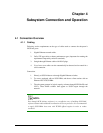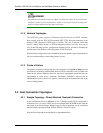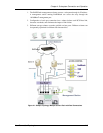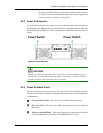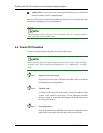
EonStor A16E-G2130-4 Installation and Hardware Reference Manual
WARNING!
All cables must be handled with care. Make sure Ethernet cables do not run parallel
with power cords. To prevent interference within a rack system, the cable routing path
must be carefully planned and they must not be bent.
4.1.2 Network Topologies
The iSCSI host ports connect to Ethernet network devices and iSCSI initiators
that comply with the IETF iSCSI standard (RFC 3720). Network connection of the
EonStor A16E subsystem’s iSCSI ports is flexible. The use of network connecting
devices, subnet, Name Servers, or iSCSI management software can vary from case to
case. In the following sections, configuration diagrams will be provided to illustrate the
possible uses of the EonStor A16E subsystem in an iSCSI network.
Note that these configurations only recommend but do not intend to impose limitations on
the use of subnet settings or networking paths to servers.
4.1.3 Points of Failure
The primary concern for configuring host-side topologies is that points of failure should
be avoided. It is therefore preferred that the host side be connected to two (2) HBAs and
better not the onboard Ethernet. Data flow and access management should therefore be
implemented to avoid access contention. Infortrend’s EonPath
™
software can be
implemented in order to discover a capacity volume through an alternate data link in the
event of cabling failure.
4.2 Host Connection Topologies
4.2.1 Sample Topology – Direct-Attached, Dual-path Connection
In the configuration shown in Figure 4-1, one (1) EonStor A16E G2130-4 subsystem is
connected to two (2) servers. These servers are equipped with iSCSI HBAs and using the
subsystem as the shared storage. Multiple arrays or logical partitions can be created and
made available separately through different ID/LUN’s on the host ports.
Note the following with the configuration as diagrammed below:
4-2 Host Connection Topologies










